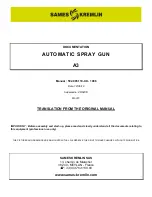
Troubleshooting
Important:
Ensure that the operator safety mechanisms for the machine are connected and in proper
operating condition before you use the machine.
When a problem occurs, do not overlook the simple causes. For example, starting problems could be caused
by an empty fuel tank.
The following table lists some of the common causes of trouble. Do not attempt to service or replace major
engine items or any items that call for special timing of adjustments procedures (such as valves, governor, etc.).
Have this work done by your engine service dealer.
Note:
When disconnecting electrical connectors, do not pull on the wires to separate the connectors.
The Charging System
20 Amp Regulated Alternator
The regulated alternator system provides AC current through two output leads to the regulator-rectifier (
). The regulator-rectifier converts the AC current to DC, and regulates current to the battery. The charging
rate will vary with engine RPM and temperature.
Note:
Stator, regulator/rectifier, and fly-wheel are not interchangeable with other charging systems.
g314087
Figure 105
1.
Stator assembly
5.
2 yellow AC input leads
2.
2 yellow leads (from stator)
6.
Regulator/rectifier
3.
Red DC output lead (from the connector)
7.
Red DC output lead (to the connector)
4.
Connector
Testing the Alternator
Important:
When checking the alternator components, preform the tests in the following sequence:
1.
Testing Alternator Output (page 76)
2.
Testing the DC Output Charging Wire (page 77)
3.
Testing the Regulator/Rectifier (page 77)
75










































